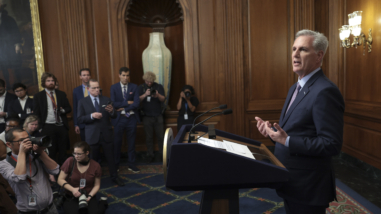Q&A with Stuart Butler: What does it take to turn ideas into government action?
 Bill Clark/CQ Roll Call
Bill Clark/CQ Roll Call
I spend a lot of time thinking about which organization or person, if brought into the idea, would be a game changer. It is important to get key leaders to champion an idea. Sometimes it’s a politician; sometimes it’s an organization. I spend a lot of time thinking about what organizations are critical.
Charter schools are an example in education. I worked with the National Council of La Raza on charter schools. We even held joint meetings and conferences when I was at the Heritage Foundation, where we really did look like strange bedfellows. That got a lot of attention. Also, I worked with the Democratic Leadership Conference (DLC), with Bill Clinton before he was president. It’s important to find champions and leaders who are surprising, and can motivate people to do a second take.
At this point in the ripening process, the idea is established among people who are most affected. With charter schools, we had built a base with the people hurt by failing public schools, especially lower-income minority families. With them we thought through questions about what charter schools would look like, how would they operate, what were the challenges. Then we were ready to go public, approaching the unions and others who were not natural allies. We did public events with La Raza, DLC, and others, which were intended to raise the profile of the issue in a public way, and with the press.
You’ve got the ball rolling, and the idea starts to gain momentum. What’s next?
If you’ve got, say, a major union open to discussion on charter schools, and its voice is listened to, and the design is amended because they are listened to — which is what happened — that gets others engaged and interested. Once that occurs, there is the potential for spreading the idea very rapidly. It becomes safer for people to come in because they can point to someone in their tent who’s already in. That happened with welfare reform in the 1990s, where President Clinton, Brookings Institution, Heritage Foundation, and others coalesced around the idea.
How do you think about timelines — short-term, medium-term, long-term — and the interplay between the gestation of an idea, gathering of support, and the political moment to push something toward the finish line?
Timing is everything. Plan for the long term, but be ready for the short term. You never know when the planets will align. Assume it will take longer than you think; don’t rush it or it will implode. The best ideas are under the radar in the political system. Sometimes the worst thing that can happen is for a prominent partisan to embrace it; they often don’t know how to explain it and the whole thing crumbles. I almost never try to move an idea forward by getting a presidential campaign to embrace it. It’s better to be under the radar and have a patient approach.
Welfare reform had some false starts.
Yes, we thought things were coming together with George H.W. Bush as President and Jack Kemp as Secretary of Housing and Urban Development, but it didn’t move. There was a lot of suspicion at the time. Then surprisingly, a governor from Arkansas became president and the opening occurred. We had been dealing for years with DLC and La Raza, and groups in the African-American community, and there was trust. And conservatives. You could get the Republicans and the White House together knowing each side was deeply committed. And there was depth in the support. Organizations had been lined up and you could move forward.
What political pitfalls did you still have to navigate at that pivotal moment for welfare reform?
One of the first things we decided on the conservative side was that we would not make welfare reform a budget issue. That was crucial. Over time, if the program was effective, we thought it would cost less, but we didn’t use welfare reform to cut the federal budget. The program was designed initially such that any savings would be available to the state to reprogram into additional services for low-income people. The way you move something in a particular political context is crucial.
That approach would be harder today.
Yes, as a former Budget Committee chairman a problem Congressman Paul Ryan has had is that a lot of his ideas had to be couched in terms of saving money and that’s been a continuous problem for him in attracting bipartisan support.
How do you recognize when the time is right to push ahead?
You have to have the elements I mentioned in place. Then it’s a judgment call. There was momentum for a structural change in Social Security before President George W. Bush came out with his proposal for personal accounts in Social Security. But it turned out the building blocks were not all there. I admit I thought that the time was right and it had fully ripened as an idea. Now it’s off the table and will be for a while. Too many organizations were not there with the vision of moving away from this collective system of social insurance into a partly individual savings model. As the politics got ugly, they abandoned it. Now I think about reform more as having an add-on to Social Security, not a partial replacement.
These phases are very important, and the early phases are crucial to getting the later phases right. Often when people put forward ideas they don’t do that initial legwork, which can take a lot of time. But if you move too quickly, it won’t work.
What is different about this process today than when you started more than 35 years ago?
The dispersal and democratization of information today actually makes it harder to move ideas forward. You don’t get the natural spread and careful build-up of ideas as easily now. If there are limited news outlets, only two or three sources of information, you can mold and spread an idea very effectively.
Also, the branding of information sources has deteriorated. Someone can look like an expert but there’s nothing behind him or her. That’s a challenge for those of us in the think tank/idea business. People with no real backing, no experience, but are good at social media can be presented as experts.
How do you believe ideas spread and gain currency?
Serious ideas still typically begin and germinate with thinks tanks and advocates and groups of people who have an adherence, and not through social media but as members, whether they are members of AARP or unions. Ideas then infiltrate into a preexisting organization through its own network and from sources considered reliable. That’s much more effective than just blogging at Brookings and thinking it’s going to spread. Hits on Twitter are ephemeral.
What are some tools and tactics you use to seed ideas in these organizations and networks?
I go back to basics. I use the telephone; I visit people and I talk to organizations, as I did in the past. I focus on building relationships. It takes a lot of my time but I think that’s the way to move things forward.
It also helps with the branding. For example, when I talk to people on the far left who are friends, and they introduce me to other organizations, I am credentialed by these people. After I have been credentialed, I send people information that they might not see otherwise. I use the material I develop in a very customized way. When I write on an issue, I write about it in multiple ways. For instance, say I had a piece in the Journal of the American Medical Association, which is a way of getting an idea credentialed by a respected journal. I often then publish the same ideas in a blog post or op-ed. I will select which form is best to present an idea to a particular organization or person.
How do you think about investing in important ideas that seem politically unfeasible in any foreseeable time frame?
Foundations and other donors, of course, need to put a lot of resources into things that are moving reasonably soon. That’s important. But it’s also really important — even though you can’t see payoff in a short time frame — to invest in developing the initial stages of ideas and keep refining them. Invest in making ideas “shovel-ready,” so when the politics line up, they are ready to go.
I’m a historian. I look at social change and see two things — it takes a long time and yet it often happens quickly and unexpectedly. You don’t always know when an idea can happen and so you have to be ready.




